Being a statue isn’t easy, especially in Old San Juan. Most people walk right by you like you aren’t even there. Others might be curious, but since you don’t even have a placard below you —or it’s so worn out that it’s unreadable— they simply go about their life and ignore you completely. What a life!!!
Yesterday I was in Old San Juan. And since I know exactly where each statue is located, I thought I might tell you a little bit about them and about the people that they actually honor.
But before I do, I thought I might mention several positive changes that I noticed in the old city. First, there’s surveillance everywhere. Yes!!!
In the past I have criticized how vandals in Old San Juan seemed to have “carte blanche” to deface public property and even destroy many of the city’s monuments and plazas. Well, yesterday it was noticeably better. Their were city officers everywhere. Some were city policemen, others wore blue and yet others wore white shirts and black pants. But regardless of their uniform you could tell that someone was minding the store.
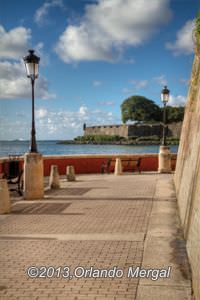
Old San Juan is getting cleaner by the minute, although the pressure wash of the city wall was pure heresy! Click on the image to see it larger
Second, the city is getting cleaner. There’s still a lot of work to do, but there were city workers sweeping and cleaning everywhere.
And finally, the repaving of the city streets continues. Fortaleza Street is almost finished and it’s looking great. Now, if they would only convert it to a pedestrian walkway that would really be something!
In Europe, most historical cities like Old San Juan are closed to vehicular traffic. Most have some sort of microbus system that moves residents between their homes and an adjacent parking area. And delivery vehicles are only allowed for brief periods during a certain time of the day.
But in Old San Juan it’s different. On one hand city officials are talking about repaving the entire city in “adoquines” (pavers) to return it to its former glory and on the other they’re allowing cars back into those same freshly paved streets to destroy them once again. I don’t get it!
If you ask me I’d close the city drawing an imaginary line, from north to south, from the corner of San Francisco and Norzagaray to the docks. From there on everybody would move on foot or on microbuses.
But enough about my thoughts on urbanism, let’s talk about statues.
Many people entering old San Juan arrive on cruise ships. They walk towards the city parallel to the Covadonga parking structure and turn left on “Paseo Covadonga” towards the Old City. Right there on the corner, in front of the Banco Popular branch, is a statue of Ricardo Alegría, a prestigious 20th century Puerto Rican archeologist and historian who was the first to preside the Puerto Rican Institute of Culture.
Don Ricardo, like most Puerto Ricans used to call him, was instrumental in rescuing and renewing many buildings in old San Juan that today are considered architectural treasures, including the world famous Hotel El Convento. Later on in his life he was also the Director of the Center For Advanced Studies About Puerto Rico And The Caribbean.
At first I thought that this statue didn’t have a placard. Then I discovered that it has an entire sign. The problem is that it’s so far away that most people never see it. At least it should have a small placard below the torso with his name.
As you continue up “Paseo Covadonga” you will find a small set of steps on your right. Going up those steps you will find a small square with the statue of Arturo Somohano in the center. Arturo Somohano was a 20th century Puerto Rican piano virtuoso who was best known for his interpretations of the works of “danza” composers Manuel Gregorio Tavarez and Juan Morel Campos. He was also the conductor of the San Juan Symphony Orchestra, which was renamed after his death as The Arturo Somohano Symphony Orchestra in his honor.
The placard under the statue is corroded and mostly unreadable.
Continuing west on “Recinto Sur Street” there is a bust at the corner with “Tanca Street” in honor of Manuel Gregorio Tavarez. Tavarez was a 19th century Puerto Rican piano virtuoso who is considered the father of the “Puerto Rican Danza”, a formal dance genre that was the craze among high society circles of the time.
His bust sits in a tiny square, with only a couple of benches, that is well kept and clean. The plaque beneath is completely legible; probably because its engraved in marble and part of the structure.
Continuing west on “Recinto Sur”, on the corner with “San Justo Street”, there is yet another small square with a small bust of Eugenio María de Hostos, a 19th century Puerto Rican educator, philosopher, intellectual, lawyer, sociologist and independence advocate. Like the larger statue of Hostos, located at “Plaza de los Niños” on “Boulevar del Valle” Street at the northwest quadrant of the city, this bust is surrounded by filth and decay.
Maybe it could have something to do with the fact that Hostos was an “independentista”, but the fact is that Eugenio María de Hostos is considered by many to have been a true genius and staunch proponent of many educational philosophies that even today are considered to be leading edge.
In 1938, the 8th International Conference of America, celebrated in Lima, Peru, posthumously paid tribute to Hostos and declared him “Citizen of the Americas” and “Teacher of the Youth”. His remains are buried at “El Panteon de los Héroes Nacionales” in the Dominican Republic. His final wish was to remain buried in the neighboring island until the day Puerto Rico gains its independence.
Oh, and yes, the bust still has its bronze placard.
A little to the west of the “de Hostos” bust is a small statue dedicated to “El Emigrante” (the immigrant), which could probably be all of us because even the Taíno Indians that populated Puerto Rico at the time of Columbus’ arrival in 1493 came from the area of present day Venezuela. So I guess we’re all immigrants.
The statue is clean, adorned with a nice landscaping and placed in the middle of a high traffic area where it can’t be missed.
You’ll have to look closely to find the next and last statue in this post. I’m referring to the statue of Felisa Rincón de Gautier, the Major of San Juan from 1946 to 1968, and the first woman to be elected Mayor of a capital city in The Americas.
The statue sits behind a metal fence, on the right hand side, about 100 feet into Paseo de la Princesa. Of course, most people never see it. Just ask anyone in Old San Juan where the statue of “Doña Fela” is and watch for the bewildered look in their face. Most of them won’t know!
And yet “Doña Fela”, like most Puerto Ricans like to remember here, was one of the most illustrious and respected women in Puerto Rican history. She worked together with Ricardo Alegría to restore and conserve historical structures in Old San Juan. Long before she was major, Rincón was also a key figure in the Puerto Rican Suffragist movement, motivating many women to go out and vote when the law was passed in 1929. And she established a network of pre-school centers called “Las Escuelas Maternales”, which John F. Kennedy used as the model to create the Head Start program in the United States.
But ask any of the old “sanjuaneros” about “Doña Fela” and you’ll be surprised to learn what she’s actually remembered for. It’s something a lot less “political”. Doña Fela was the first and only Puerto Rican official to bring plane loads of snow just so the poorest children of the city would know what it was like to play in it during Christmas season.
Regardless of all the great things that she did for San Juan, and for Puerto Rico as a whole, most people will say: “yeah, she was the one that brought snow to San Juan”.
Well, in my humble opinion her statue should be in a prominent place in her beloved “Old San Juan”. Not behind a metal fence where nobody ever sees it. I’m just saying…
There are many more statues in the old city. Some are beautiful and well kept and others are in a sad state of keep. But hey, I’ll tell you about all of them. However, this post is getting kind of long, so next time I’ll show you the rest.
In the mean time take a minute to explore Puerto Rico By GPS.
Enjoy Puerto Rico,
©2013,Orlando Mergal, MA
____________________
Bilingual Content Creator, Blogger, Podcaster,
Author, Photographer and New Media Expert
Tel. 787–750-0000, Mobile 787–306-1590
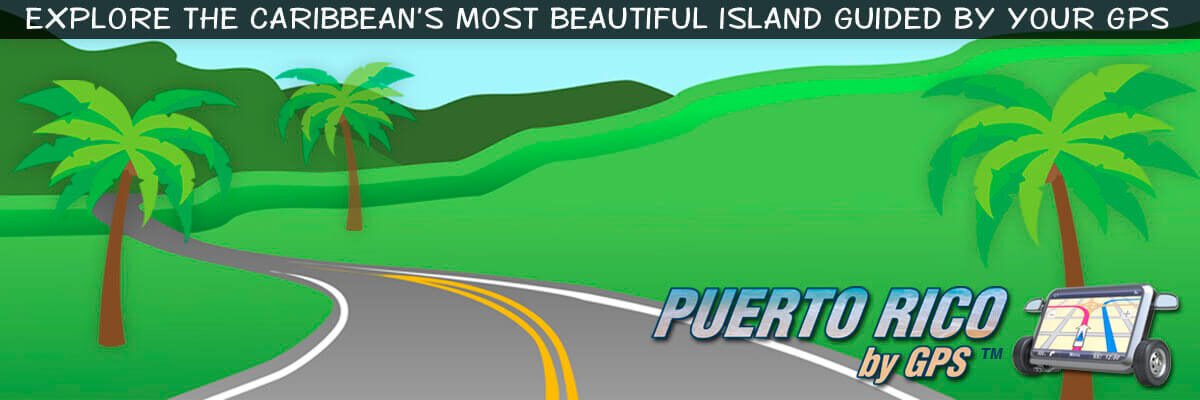
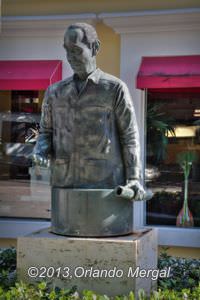
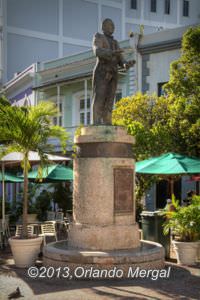
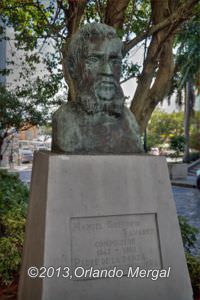
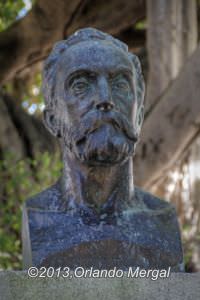
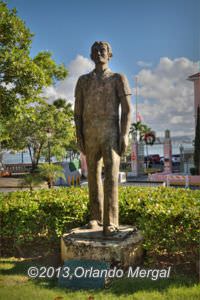
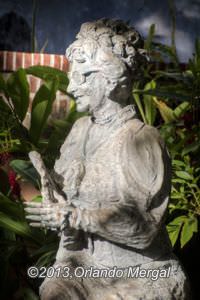

I am 72 years old and have lived in Puerto Rico for 55 years. Thanks to your publishing this item; I am planning my own personal walking tour of Old San Juan passing by each of these statues. I have visited “La Rogativa”, one of my favorites many times. I often go to “Paseo la Princesa to listen to trios, etc. I have seen some of others, but not all. I am looking forward to a great day in Old San Juan thanks to you.